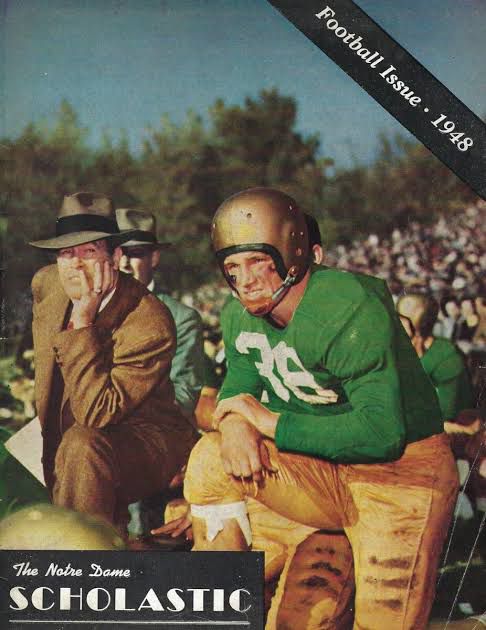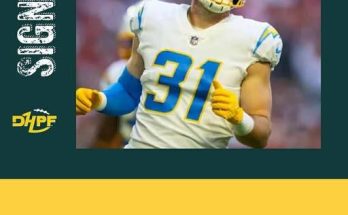**FLASHBACK TO GLORY: Inside the 1948 Scholastic Football Publication That Captured the Golden Era of Notre Dame Football**
The brittle pages crackle with history, their faded ink whispering tales of a bygone epoch when college football wasn’t just a sport but a national religion. The 1948 edition of *Scholastic Football Review*, its cover adorned with a gold-helmeted warrior charging through autumn mist, stands as perhaps the most significant time capsule from Notre Dame’s second “Golden Age” – a season when Frank Leahy’s Fighting Irish didn’t just dominate opponents but elevated the game itself to mythic proportions. This wasn’t merely a magazine; it was a holy text for the subway alumni, capturing the essence of what made post-war Notre Dame football the standard by which all programs would forever be measured.
Leafing through the publication’s sepia-toned pages today is like unearthing a Rosetta Stone of football philosophy. The lead feature breathlessly details Leahy’s infamous “two-platoon” system, a revolutionary approach that saw separate offensive and defensive units – a luxury few programs could afford in those roster-limited years. “Notre Dame doesn’t substitute,” wrote the anonymous scribe in a passage that still resonates, “they deploy fresh regiments against weary conscripts.” The accompanying diagrams of Leahy’s T-formation variations look primitive by modern standards, yet contain strategic nuances that would influence offenses for decades. One particularly prophetic sidebar highlights a sophomore guard named Bill Fischer, his granite jaw set in a black-and-white photo, with the caption: “This man will redefine line play.” (Fischer would win the Outland Trophy that season and later be enshrined in Canton.)
The magazine’s heart lives in its player profiles, each one reading like pages from a medieval epic. Here’s Leon Hart, the 230-pound “unicorn” who played both tight end and defensive end with equal ferocity, his hulking frame immortalized mid-block in a spread that declares him “too strong for ends, too fast for tackles.” A turn of the page reveals quarterback Johnny Lujack’s personal diary entries from Heisman week, including his now-legendary pre-game ritual of chain-smoking Luckies to calm his nerves. Most poignant is the tribute to George Connor, the two-way lineman/LB hybrid whose 60-minute performances inspired Leahy’s famous quote: “A football team is 11 Connor-shaped men and the poor souls trying to stop them.”
What makes this particular *Scholastic* edition transcendent are the interstitial details modern publications would never dare include. Scattered between game summaries are handwritten margin notes from the sports information director tracking the team’s weekly bean consumption (3,200 lbs for the season) and laundry soap usage (142 lbs per road trip). A full-page advertisement for South Bend’s Oliver Hotel boasts of housing the “cleanest visiting teams in the Midwest” thanks to their industrial-sized showers. Even the classifieds section thrums with period charm, featuring a local butcher offering “discount T-bones for any player who scores twice against Purdue.”
The magazine’s cultural impact becomes clear when examining its distribution maps. Originally printed for 5,000 alumni subscribers, demand exploded after Notre Dame’s infamous 12-7 “Game of the Century” victory over Army, forcing the university to order three additional press runs. Copies reportedly circulated through GI Bill dormitories from Boston to San Diego, their play diagrams studied like Talmudic texts by aspiring high school coaches. Former players would later credit these pages with democratizing Leahy’s system, allowing small-town programs across America to emulate Notre Dame’s precision.
Perhaps no section better encapsulates the era’s ethos than the letters to the editor. A priest from Chicago laments the “decline of sportsmanship” in opposing teams who dare pass against Notre Dame’s second-string. A factory worker in Detroit argues that Hart should be prohibited from playing “for the safety of the sport.” Most remarkably, there’s a handwritten note from a 17-year-old Pennsylvania prospect named Chuck Bednarik – future NFL ironman – asking what exercises might help him “grow into a Connor-shaped man.” (Leahy himself reportedly penned the response, suggesting “farm work and hatred of forward passes.”)
The magazine’s final pages contain what may be college football’s first true advanced stats section, with a professor from Notre Dame’s mathematics department calculating that the ’48 Irish averaged 4.3 yards per carry when running left of Fischer versus 3.1 elsewhere. There’s even a primitive “win probability” chart showing how Notre Dame’s defense allowed just 12 second-half points all season, a record that still stands. These analytics, crude by today’s standards, reveal how far ahead of its time Leahy’s program truly was.
Seven decades later, the ’48 *Scholastic Football Review* remains required reading in Notre Dame’s football offices. Current head coach Marcus Freeman keeps a framed copy in his private study, telling recruits it represents “the DNA of Irish football.” The magazine’s lasting power lies not in its yellowed statistics or outdated training tips, but in how perfectly it crystallizes a moment when Notre Dame didn’t just play football – they authored its future. As we turn the fragile final page, we find Leahy’s own typewritten maxim, its truth undimmed by time: “Greatness isn’t built in seasons, but in details pressed between the pages of history.” The 1948 Irish didn’t just leave a championship legacy – they left a blueprint, forever preserved in these hallowed pages.



